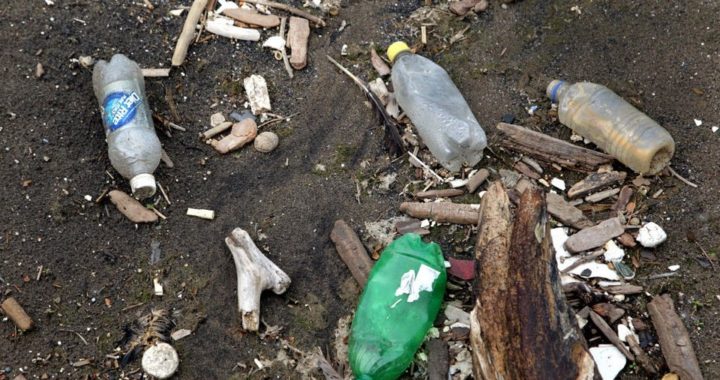Plastic pollution doesn’t just threaten sea turtles and
marine mammals – human health is at risk as well.
That was the message Thursday evening from a panel of
environmental activists and government officials who spoke at the Rocky River
Public Library. The discussion was sponsored by the League of
Women Voters and the Bay Village and Rocky River Green Teams.
Panelists were Cheryl Johncox of the Sierra Club Ohio;
Cuyahoga County District 11 councilwoman Sunny Simon; Sarah Damon from
Surfrider Foundation; Sarah Mathews from Rumpke Waste; and Cristie Snyder from
the Cuyahoga County Solid Waste District.
Panelist discussed a number of issues related to plastic
pollution, including growing health concerns, the role of fracking in plastic
manufacturing, recycling, and House Bill 242. They urged attendees to become
informed, take the problem seriously, take individual steps to reduce their use
of plastic – especially single use plastic – and push legislators to enact
policies that reduce plastic pollution.
Health impacts
Problems with plastic are magnified by a crucial characteristic: it never goes away. Except for the tiny fraction of plastic that has been incinerated, all of the plastic that has ever been produced remains in landfills or in the environment. Over time, plastic in the environment breaks down into smaller and smaller pieces, but it never breaks down chemically. These tiny particles are now found everywhere, from Antarctica, where they have been deposited by the wind, to your drinking water, to your bloodstream.
Plastic particles have even been found in human umbilical blood, said Johncox. “It is in all of our bodies right now.”
The health effects of long-term exposure to ingested plastic
particles are still being studied, but Johncox said that we already know enough
to be concerned about the plastic loading in the environment. “The science is
not new on plastics,” she said. “It has been coming out of Europe for thirty
years.”
In the United States, however, the petrochemical industry and their lobbyists have suppressed research into plastic’s effect on human health, added Johncox.
Still, it is widely known that elements of plastic act as
endocrine disruptors, interfering with many of the bodies’ essential processes,
said Johncox. These toxins affect human development, she added. Infants, people
with chronic diseases, and the elderly are especially vulnerable.
It is worth noting, said Johncox, that the American Academy
of Pediatrics recommends that parents not give children food or drink from
plastic containers whenever possible.
We Are Using More and More
While awareness of the dangers of plastic has been growing
in recent years, the plastic industry has ramped up production. “Fifty percent of the plastic in the world
today has been produced since 2013,” said Johncox.
While there are several reasons for the surge in plastic
production, a key factor has been the growing use of fracking – hydraulic
fracturing – as means of drilling for gas.
“A side product of the fracking process is feedstock for
plastic production,” said Johncox.
Fracking yields significant amounts of ethane, which can be
converted, or ‘cracked,’ to create ethylene, a key component of many types of
plastic. The growing availability of inexpensive ethane has boosted plastic
production and is sparking construction of new cracking facilities. Many of
these facilities are planned or are under construction in Ohio, West Virginia,
and Pennsylvania, states where fracking is concentrated.
Recycling
Recycling is helpful process, but it is very far from the
solution to plastic pollution, said panel members.
Plastic recycling rates are low, currently less than 10 percent of the plastic used in the United States is recycled. For plastic bags, the numbers are even worse. “Only one or two percent of people recycle their bags,” said Simon.
In the past two years there has been a major change in the
world markets for recycled material.
Most notably, China has stopped taking recycled material from the United
States. Sarah Mathews, of Rumpke Waste, said recycling is going through an
especially difficult time, as the lack of markets restricts the material that
they can sell. “End users determine which products can be recycled,” said
Mathews.
As a result, cities across the country – including communities
in Greater Cleveland – have limited the types of plastic they can accept in
their curbside recycling programs.
Generally, in Greater Cleveland, the only types of plastic that are
accepted are bottles and jugs. All other plastic ends up in a landfill or out in
the environment.
But Rumpke remains committed to recycling as an industry. “We are continuing to make investments on our
recycling facilities,” Mathews said.
Plastic recycling is a last resort, said Johncox. “Our first
choice should be to reduce – ask yourself, ‘do I really need this?’ If you
can’t reduce, then reuse it. If you can’t reduce or reuse it, recycle.”
Mathews said recycling issues include contamination and
wishcycling.
Contamination is a huge problem for recycling facilities,
said Mathews. Reduces the value of other material, threatens the safety of
recycling works, and damages recycling equipment.
Wishcycling is the practice of tossing non-recyclables into the recycling bin because you want them to be recycled, regardless of whether they actually will be recycled. Mixing recyclables and non-recyclables in recycling bins contaminates the contents of the bin, and often leads to landfilling of otherwise recyclable material, said Snyder.
“You can’t throw everything in the recycling bin and expect
someone else to straighten it out,” said Snyder. “That only causes more
problems.”
And even when plastic is recycled, it is not truly recycled the way aluminum, steel, or glass can be. Plastic from bottles and jugs that is collected for recycling is not used to make new bottles or jugs. Instead, it used to create other plastic products, like park benches or playground mats. This is known as ‘downcycling,’ and while it reduces the amount of new plastic being produced, it doesn’t really remove the plastic from the environment. Eventually those benches and mats will break down and begin to leach tiny particles into the environment. By downcycling we have just delayed the process. Far better not to produce those plastic bottles in the first place.
Bag Ban / HB 242
The potential harm and the low rate at which bags are recycled prompted Councilwoman Simon to sponsor a county ordinance that will prohibit retailers from providing plastic bags. the ordinance passed earlier this year and will take effect on January 21, 2021.
But Ohio state legislators are currently considering a bill – HB 242 – that would prevent local communities, like Cuyahoga County, from banning or taxing single-use plastic bags or other containers. The bill could pass Ohio’s Republican-controlled House and Senate before the end of this year and if it does it would prevent Cuyahoga County’s bag ban from taking effect. Sunny Simon warned that the impact of HB242, if it passes, will be “irreversible.”
HB 242 is part of a nationwide effort by the plastic
industry to pre-empt regulation of plastic bags or other products, said Sarah
Damron, of the Surfrider Foundation. Fifteen states already have pre-emptive
laws on the books.
Many of these laws – including Ohio’s –
were prepared with the assistance of the Progressive Bag Alliance, a plastics
industry lobbying group that is fighting efforts to regulate plastic across the
United States, said Damron. On its website, the Alliance describes itself as “The frontline defense against plastic bag bans and taxes
nationwide.”
Simon said that she knew the pre-emption effort was coming,
even as she worked to pass the county ban. Even if state law prevents implementation
of the county’s bag ban, she said, passing the ban was worth it. “Raising
awareness and consciousness about the issue is valuable, whether we get
pre-empted or not.”
The county plans to conduct a public education campaign to inform
consumers of the ban and explain the importance of the action. The goal of the
ban, she said, is to change consumer behavior. “As consumers, we should reject
plastic bags, straws, and other single-use plastic.”
If HB 242 becomes law, said Simon, the county will challenge
the law in court, arguing that the law unconstitutionally interferes with the
home rule powers of local communities.
What can people do?
The panel agreed that reducing the harm from plastic in the
environment will require public awareness; changes to consumer behavior; and some
forms of regulation, including bans, fees, and producer responsibility laws.
But Individuals don’t need to wait for government or
industry to respond. Consumer pressure is one of the key drivers leading
manufacturers to reduce packaging waste, said Damron, and continued consumer
pressure can accelerate change. Individuals can stimulate change by:
- Refusing to accept single-use plastic packaging.
- Reducing and reusing products and packaging
whenever possible.
- Recycling properly to reduce contamination in
the recycling stream.
- Opposing HB 242 – contact your state legislators
and make your views known.
- Learn about plastics and share your information
with others.
“We can all make a difference,” said Mathews.
August 30, 2019



